
Climate change has resulted in drastic seasonal fluctuations leading to erratic rainfalls and prolonged droughts in India. This has been posing an increasing threat to the agriculture and food security of the country, with increasing stress on rural livelihoods and resources such as land, soil, water and forests. To cope with this stress, farmers and land labourers in rural areas of India have started migrating seasonally, either temporarily or permananetly, to urban areas in search of livelihoods.
The article titled 'Rainfall variability, food security and human mobility in the Janjgir-Champa district of Chhattisgarh state, India' published in the journal Climate and Development, presents the findings of a study that looks at the impact of rainfall and climate change on agriculture, livelihoods and migration among farmers from four villages of Janjgir Champa district of Chhattisgarh.
Rainfall and its impact on agriculture and livelihoods
Rainfall data for the state shows that its rural areas are most vulnerable to impacts of disasters and climate change. A significant population is dependent on rain-fed agriculture, animal husbandry, fisheries, and forest-based livelihoods and thus any changes in rainfall and temperature significantly impacts their lives.
Recent evidence shows that the total number of rainy days per year has decreased in the state. Although most of its agriculture depends on irrigation by canal water, a large section of population depends on rain water for their livestock and crops as the canal water depends on the availability of rain water. In addition, newly established power plants in the region also use canal water, which increases the stress on the already scarce resource.
Rice is the main crop grown in the area with around 20% of the area under irrigation, and the rest is under rain-fed conditions. Due to the change in rainfall patterns and a shift in the monsoon in terms of delayed onset, farmers in Chhattisgarh have started relying more and more on short or medium duration rice varieties.
Underreporting of migration in rural areas
Government representatives blame the monoculture of paddy as a food security threat for the farmers, while farmers blame the unavailability of sufficient canal water as a reason for them to avoid growing a second annual crop. This water insecurity and its impact on livelihoods has been leading to people migrating to other places in search of better/alternative livelihoods. Trends show that communities are attracted to urban areas, but farmers who migrate with their families have to face a number of challenges while trying to establish themselves there.
Government officials tend to underreport this drought-induced migration due to the fear that this would be viewed as a failure of government mechanisms. Therefore, they tend to highlight the monoculture as an important issue rather than migration.
The way out
The study finds that shorter and more delayed rainy seasons and decreased income due to less crop production are forcing farmers to migrate to urban areas. The article ends by suggesting some measures that need to be undertaken to prevent the increasing migration in the area. These include the following:
- Equipping farmers with new skills to help them seek improved or alternative livelihoods in the case of water scarcity or crop failure, without having to move elsewhere.
- Raising awareness of the farmers about the importance of rationalising the use of the little water available in ponds, and the necessity of not polluting it by using it as a sewer for disposing human and animal waste.
- Raising awareness among farmers about the possibility of diversifying their agricultural production by introducing new crops for improving food security and reducing vulnerability.
- Helping to balance the accessibility to the canal water between the farmers and the power plants, such that both activities work in parallel and the gains of the limited resources in both sectors are maximised.
Please download a copy of the paper below.